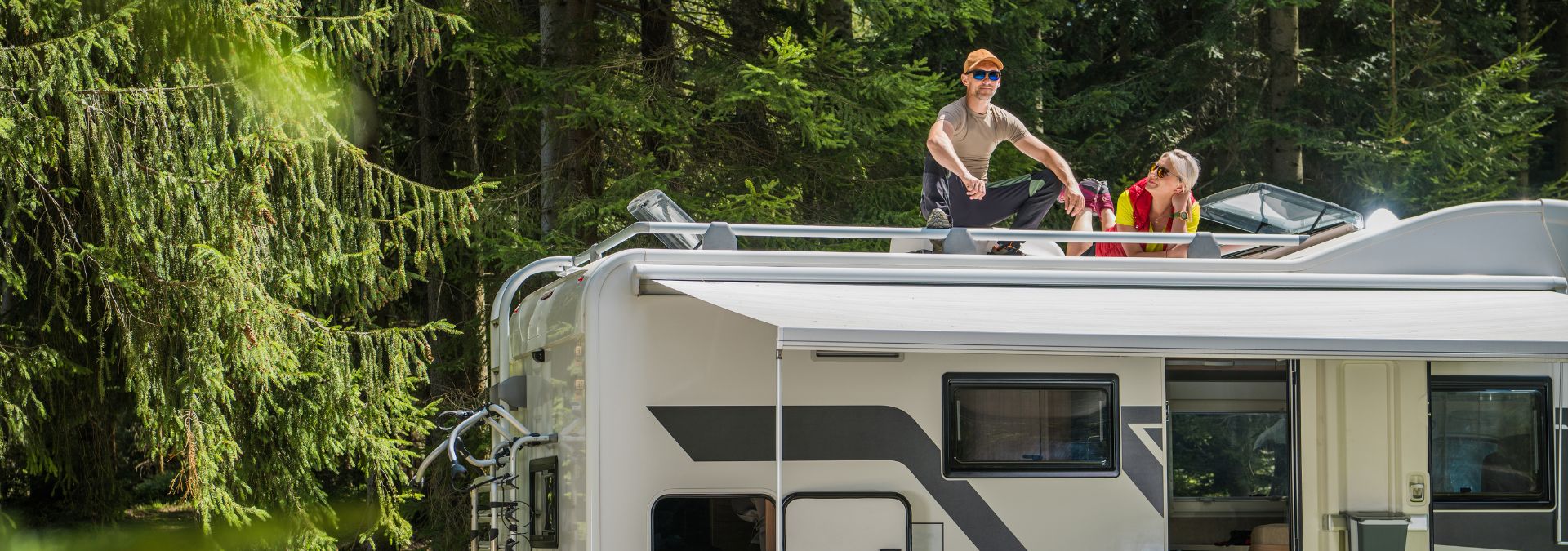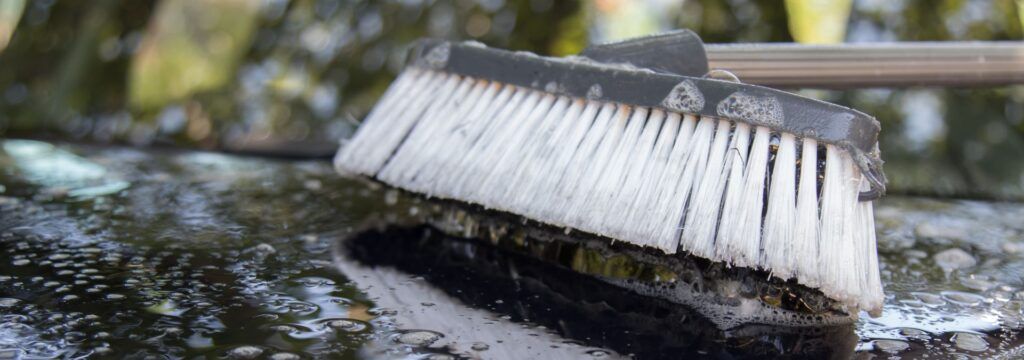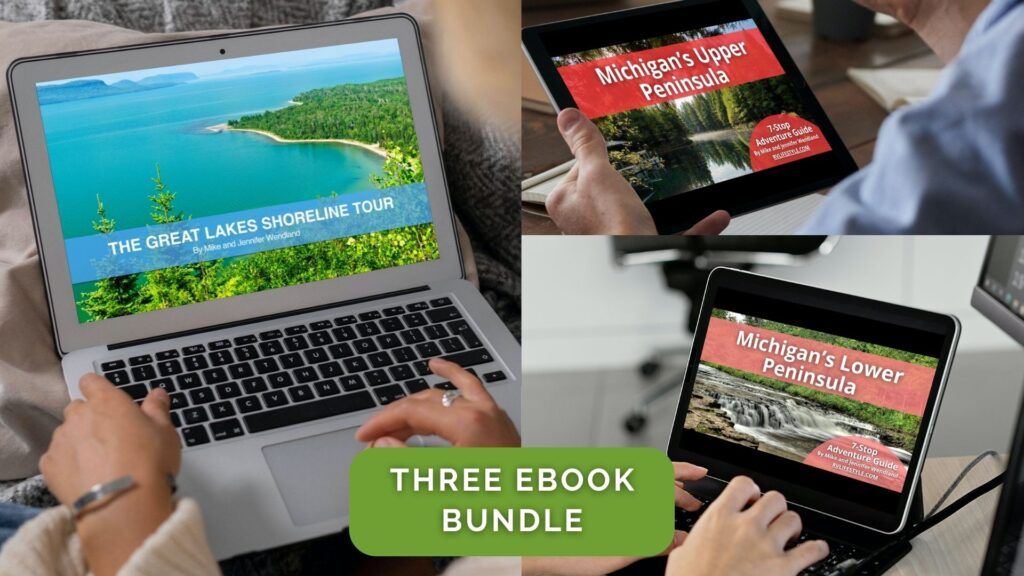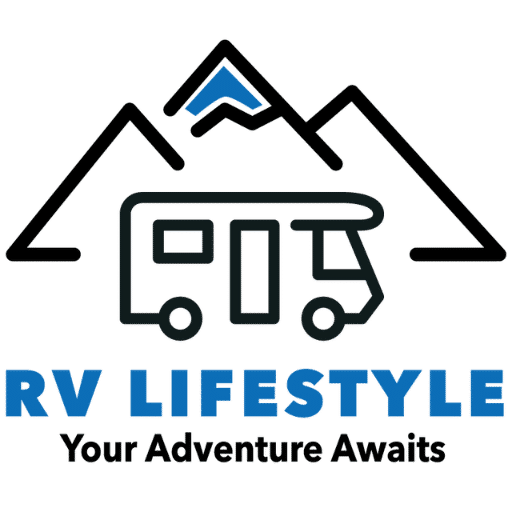The Best Way to Clean Your RV Roof (A Simple Guide)

A clean roof will save you money and trouble in the future! So, here's a step-by-step guide on the best way to clean your RV roof…
Maintaining your RV is one of the most important tasks to keep your RV in good working order. The roof is your first line of defense against the elements, and a weak defense will cost you a lot of money in the long run.
An improperly maintained roof will eventually allow water to seep and leak into your RV, damaging your ceiling, walls, and your electrical system. Furthermore, it can cause mold and mildew, which is very dangerous for your health.
So, to help you avoid all of these costly and dangerous issues, we'll walk you through the best way to clean your RV roof. A clean RV roof is a healthy RV roof!
If you buy something through our links, we may get a small commission at no extra cost to you. It helps keep our lights on so we can continue to provide helpful resources for RVers. Read our full affiliate disclosure here.
How Often Should You Clean Your RV Roof?

You should clean your RV roof 4 times a year, ideally every season. However, if your RV is stored covered for long periods, you may not need to clean it as frequently. Or, if you travel often, you may need to clean it more often.
Always refer to your RV owner's manual for specific instructions regarding your roof maintenance schedule.
Types of RV Roofs
There are 4 main types of RV roofs, each with its own characteristics. We'll break down the key points for you quickly.
1. EPDM Roof or TPO Rubber RV Roof
- Made from rubber or thermoplastic olefin materials.
- Durable, flexible, and resistant to UV rays, ozone, and weather elements.
- Requires regular cleaning with a non-abrasive cleaner designed for rubber roofs.
- Never use products with petroleum distillates or petroleum solvents
- Recommended to apply a UV protectant coating every two years.
2. PVC Roof
- Made from polyvinyl chloride material.
- Easy to clean using household cleaners like dish soap.
- Does not require a special UV coating.
3. Fiberglass Roof
- Constructed with layers of fiberglass material.
- Can be cleaned with dish soap or designated RV fiberglass cleaner.
- To avoid it chalking over time, clean, buff, and coat it with a floor wax.
4. Aluminum RV Roof
- Made from aluminum material.
- Cleanable with dish soap or designated RV aluminum cleaner.
Looking for the right RV roof cleaning product? We have an article on the Best RV Roof Cleaners to help you select the best product for your RV.
The Best Way to Clean Your RV Roof
The following is how we recommend cleaning your RV roof. Keep in mind that owner's manuals and different cleaning products may have different instructions than what we outline below. If so, follow the instructions in your owner's manual and on your cleaning product's label.
Step 1: Consult Your Owner's Manual

The first thing you need to do is consult your RV owner's manual. Follow any special instructions regarding cleaning frequency and recommended products specific to your type of roof.
Step 2: Determine If It's Safe For You to DIY
Honestly consider your own physical ability and safety when deciding if you can safely clean your RV roof. If you're unsure or have concerns, it's better to ask for help from a family member, friend, or professional RV cleaning service.
Step 3: Safety Preparations

Ensure your safety while cleaning the RV roof by following these safety precautions:
- Wear grippy shoes and use a secure ladder.
- Use a rope or backpack to carry cleaning products/tools instead of holding them while climbing the ladder.
- Have a spotter present or inform someone that you'll be working on the roof and set a time to check-in.
- Never walk on any wet surface of the roof.
- Use a piece of plywood to distribute your weight if the roof feels unstable.
- If you can't safely walk on the roof, work from a stable ladder instead.
Step 4: Sweep & Hose Down Your RV Roof
Remove any debris by sweeping the roof or using a leaf blower. Then, it's a good idea to hose down the roof to remove any remaining loose dirt or debris. Be cautious not to walk on any wet areas.
Step 5: Use the Right Roof Cleaner
Choose a roof cleaner that is safe and suitable for the type of roof on your RV. If you have an EPDM or TPO rubber roof, make sure to use a rubber roof cleaner.
For PVC roofs, you can use household cleaners like dish soap. Fiberglass roofs can be cleaned with dish soap or a designated RV fiberglass cleaner.
If you have an aluminum roof, use dish soap or an RV aluminum cleaner.
Step 6: Scrub a Dub Dub

Some roof cleaners may not require scrubbing, so follow the instructions on the product label. For those that do, you'll need the right scrub brush to avoid scratching or digging into your roofing material.
For an RV rubber roof like EPDM or TPO roof, opt for a medium bristle brush or a soft bristle brush suitable for the type of rubber. Scrub the roof gently in a circular motion, paying close attention to stubborn stains or black streaks.
For fiberglass or aluminum roofs, use a non-abrasive scrub brush or a soft cloth.
Step 7: Rinse
Not all roof cleaners require scrubbing, so follow the product instructions in such cases.
For those that require rinsing, thoroughly rinse off the roof, removing any remaining cleaning solution. It's important to rinse off all the cleaner to prevent any residue from affecting the roof material.
Step 8: Apply Protectant as Necessary
If your roof type requires a UV protective coating, apply it as instructed. EPDM or TPO rubber roofs often benefit from a protective UV coating every two years.
This coating helps prolong the life of the roof and protects it from the damaging effects of the sun's rays. Follow the product instructions for the application process.
Step 9: Inspect Seals & Check for Damage
Take a moment to inspect the seals on your RV roof and check for any signs of damage. Look for cracks, tears, or any areas where water can potentially leak into your RV.
Address any issues promptly to prevent further problems and ensure the integrity of your roof.
Step 10: Let Dry Completely Before Covering
Allow your RV roof to dry completely before covering it. The roof must be completely dry to prevent moisture-related issues such as mold or rot. Make sure to allow enough time for the roof to air dry before taking any further steps.
Should You Use a Pressure Washer to Clean Your RV Roof?
Using a pressure washer to clean your RV roof is not recommended. High-pressure water can potentially damage seals and remove protective coatings.
Stick to the gentle cleaning methods outlined in this guide for the best results and to avoid any unnecessary damage to your RV's roof.
How to Get Tree Sap Off Your RV

Keeping your RV roof clean is a challenge, especially when it comes to sap. The sticky substance is bad enough when it’s wet but even worse when it dries and hardens.
It’s a problem most RVers have to deal with, which is why it’s no surprise a member of our RV Lifestyle Facebook group reached out for advice.
Tom posted: “Hi fellow campers. I do a lot of camping at state parks with big pine trees. I am so sick and tired of all the sap…”
He goes on to ask the community for advice on how to get this sap off, and the community answered with over 100 comments. We share their helpful advice in this article… Keep Reading…
Great Product for Removing Bug Splatter
Like what you see in these videos? We'd appreciate it if you would Subscribe to our YouTube Channel (easy to do right here) and consider “ringing the bell icon” to be notified of any new video from us. ???? Thanks!
Speaking of clever ways to keep your RV clean, Jennifer shares a great product for removing bug splatter in this video. Click here to learn more about the product.
| Preview | Product | Price | |
|---|---|---|---|

|
Bugs Off Pads | $22.98 | Add to Cart |
Mike and Jennifer's Ultimate Michigan and Great Lakes Bundle – THREE ebooks

This bundle contains our ever-popular Michigan Upper Peninsula 7-Stop Adventure Guide PLUS the NEW LOWER Michigan Adventure Guide PLUS the US Side Tour of the Great Lakes! This ULTIMATE Bundle will help you keep enjoying Michigan and the Great Lakes for years!
You can see ALL our eBooks here, or use the following Quick Links to go straight to what you need!
● Adirondacks ● Arizona ● Colorado ● Coastal Maine ● Florida’s Atlantic Coast ● Florida’s Gulf Coast ● Florida Keys ● Great Lakes Shoreline ● Natchez Trace ● Southern Utah ● Upper Peninsula ● Lower Peninsula ● Yellowstone ● Bourbon Trail ● Yosemite
And MANY of these are BUNDLED together:
Northeast Bundle
Coastal Maine, Adirondacks
Ultimate Michigan and Great Lakes Bundle – 3 ebooks –
Upper Peninsula, Lower Peninsula, and the Great Lakes Tour
Michigan Bundle
Upper Peninsula, Lower Peninsula
The Great Lakes Adventure Guide Bundle
The Great Lake Shoreline Tour & JUST the Upper Peninsula Guide
Florida Adventure Guide Bundle
Gulf Coast, Atlantic Coast, Keys
Southwest Adventure Guide Bundle
Arizona, Colorado, Southern Utah)
Ultimate 7-Day RV Adventure Guide Bundle
Collection 1- our first 10 ebooks (does NOT contain Great Lakes Shoreline, Natchez Trace, The Bourbon Trail, and Yosemite)
We also have a nice collection of ebooks that will help you navigate the RV Lifestyle.
Like these:
RV Buying Secrets – The Beginner's Guide to Boondocking – The Ultimate Guide to Cheap or FREE RV Camping Sites – Boondocking and Free RV Camping EBOOK Bundle – Winter Camping – Newbie Guide
And ONE PRINT book 🙂 and yes, before you ask, we have plans for MANY more print books.
The Complete Guide to Boondocking – PRINT VERSION
This is the same as the ebook titled The Beginner's Guide to Boondocking but in print.
And while you are exploring all our ebooks – check out the hoodies, T-shirts, Stickers, and mugs in our MERCH Store! You can get to it directly by just going here – SHOP!
Last update on 2025-04-30 / Affiliate links / Images from Amazon Product Advertising API

Great article for every RV owner especially for those who are new in the RV world. Well, if I talk about mine, I always use RV Roof Magic’s “Roof Protect/Cleaner” as it is the best biodegradable and ecofriendly product that I have experienced. Roof Protect emulsifies contaminants and provides improved surface preparation and adhesion by effectively removing oil, grease, mildew, dirt, and other soils from your roofing membrane. It also contains a mildewcide to kill any mold spores. For its application, 1 cup of Roof Protect is enough for every 5 cups of water. Wash down the roof with water then scrub with a soft bristle brush and thoroughly rinse and let it dry.